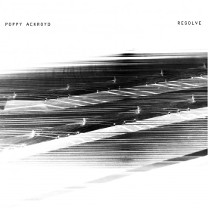The Graham Album Review #1935

Click on CD Cover for Audio Review in streaming mp3 format | |
Poppy Ackroyd: Resolve
by George Graham
(One Little Indian Records As broadcast on WVIA-FM 3/28/2018)

Click on CD Cover for Audio Review in streaming mp3 format | |
Poppy Ackroyd: Resolve
by George Graham
(One Little Indian Records As broadcast on WVIA-FM 3/28/2018)
The late 1980s and 1990s were the heyday of New Age music, with tinkling pianos, ruminating acoustic guitars and spacey synthesizers. The style seems to have largely played out in recent years, with the general music scene sounding more in-your-face in keeping with the culture of media and politics. But there are some creating music that might be considered a kind of contemporary version of the contemplative or impressionist styles of the New Age scene. This week we have an interesting British artist whose music starts with her classical background and uses a combination of technology and acoustic instruments to create a distinctive and appealing sound. Her name is Poppy Ackroyd, and her new release, her third, is called Resolve.
Poppy Ackroyd is a London native, but is currently based in Brighton, England. As mentioned she brings a classical background to her music. She plays both violin and piano, and performs as a member of a Scottish group The Hidden Orchestra, headed by Joe Acheson. In 2012, she released her own first album called Escapement, which used sampling technology to make all the sound on the album by manipulating the bits of piano and violin. She followed that up in 2014 with a recording called Feathers which added some additional instrumentation. Now she is out with Resolve, which goes another step and features additional musicians, playing reed instruments, Mike LeSirge; cello, played by Jo Quail, and an instrument called a “hang,” which is a kind of variation of the Trinidadian steel drum, played by Manu Delago.
The result is a sonically creative record that features the kind of minimalist composing style of sequenced synthesizers with the instrumentation being acoustic at its root. The compositions are more harmonically interesting and than typical New Age, but also have the kind of repeating motifs of the minimalists, which has also long been part of New Age electronica. The music on Resolve has a cinematic quality, one can easily imagine it being used behind perhaps, a film noir production.
The album opens with a piece called Paper, which sets the tone for the project. The music recalls the New Age scene of a quarter century ago, but it features Ms. Ackroyd’s distinctive hybrid of electronic-sounding sequencing with acoustic instrumentation, including the violin and cello. The melodic line is also quite appealing. <<>>
A piece called Light ironically has a distinctly darker texture in its mood. The arrangement is also imaginative, with the a kind of altered piano sound contrasting with the melancholy-sounding string lines. <<>>
Perhaps the most distinctive piece on the album, which epitomizes the technique of electronically sequencing acoustic instrumentation sounds, is called The Calm Before. It uses a fragment of a clarinet note played by Mike LeSirge as a kind of percussive sound, with LeSirge adding more woodwinds. <<>>
The title piece Resolve also has a darker, ruminating sound with the piano forming the sonic center of the piece. This is a good example of the cinematic quality of the Ms. Ackroyd’s music. One could imagine it providing the backdrop for a dark scene in perhaps a psychological drama. <<>>
The “hang” instrument, the steel drum variant, is spotlighted on a track called Time in which the hang is used as a combination of the tonal and rhythmic elements. <<>>
The strings serve a similar role on a piece called Quail. There’s not much to it melodically, but but it offers some interesting sonic textures. <<>>
Another piece that is also rather light on melodic content, but features interesting sonics is Luna. In this case it’s the plaintive sounding string arrangement that is the focus. <<>>
The album ends with a piece called Trains, which is the most repetitive on the album, in a style in which repetition forms the basis. But this one doesn’t really take off from there, as many of the other pieces on the album do. <<>>
Resolve the new third album by British composer, pianist, violinist and sonic manipulator Poppy Ackroyd is a creative contemporary update to the instrumental electronic music that was mainstay of the new age scene of the 1980s and early 1990s. What makes it interesting is the way she uses her and her colleagues’ acoustic instrumentation to create music that sounds electronically sequenced like synthesizer projects. She is a worthy composer and arranger, though some of the tracks can get a bit monotonous in their repeating lines. She takes after the minimalist composers who repeat musical figures and gradually evolve them over time. Sometimes it works well, when there’s an interesting melodic line, but at others the discernible melodies are pretty thin for the repetition. In fairness, the credits say “performances and improvisations” in listing the musicians present. But overall, it’s quite engaging.
Our grade for sound quality is an “A.” The sonic manipulation is well-handed and the sound remains clean and undistorted, even with all the sampling done. The dynamic range is better than average with the recording maintaining the distinctions between loud and soft better than many contemporary albums.
The great majority of electronic music these days is dance oriented. It’s nice to hear an artist who uses the technology to make “arty” often contemplative instrumental music like this that can also be quite approachable.
(c) Copyright 2018 George D. Graham. All rights reserved.
This review may not be copied to another Web site without written permission.
 To Index of Album Reviews | To George Graham's Home Page. | What's New on This Site.
To Index of Album Reviews | To George Graham's Home Page. | What's New on This Site.